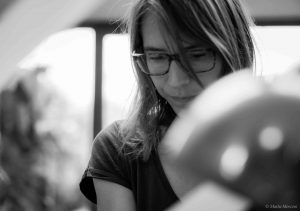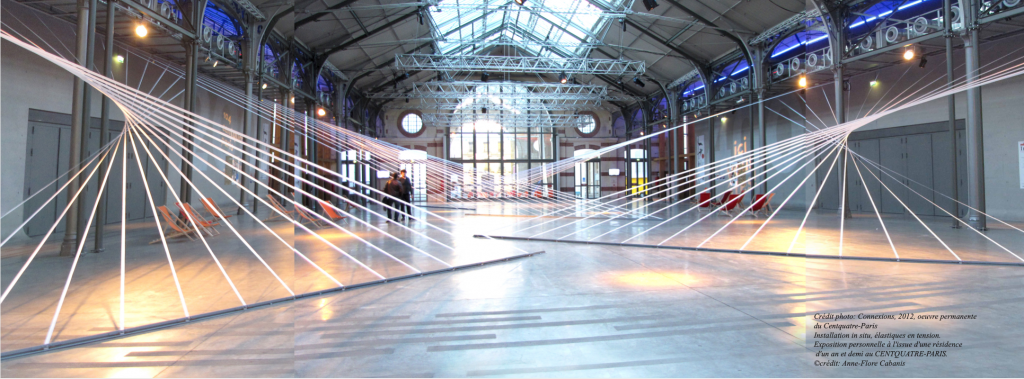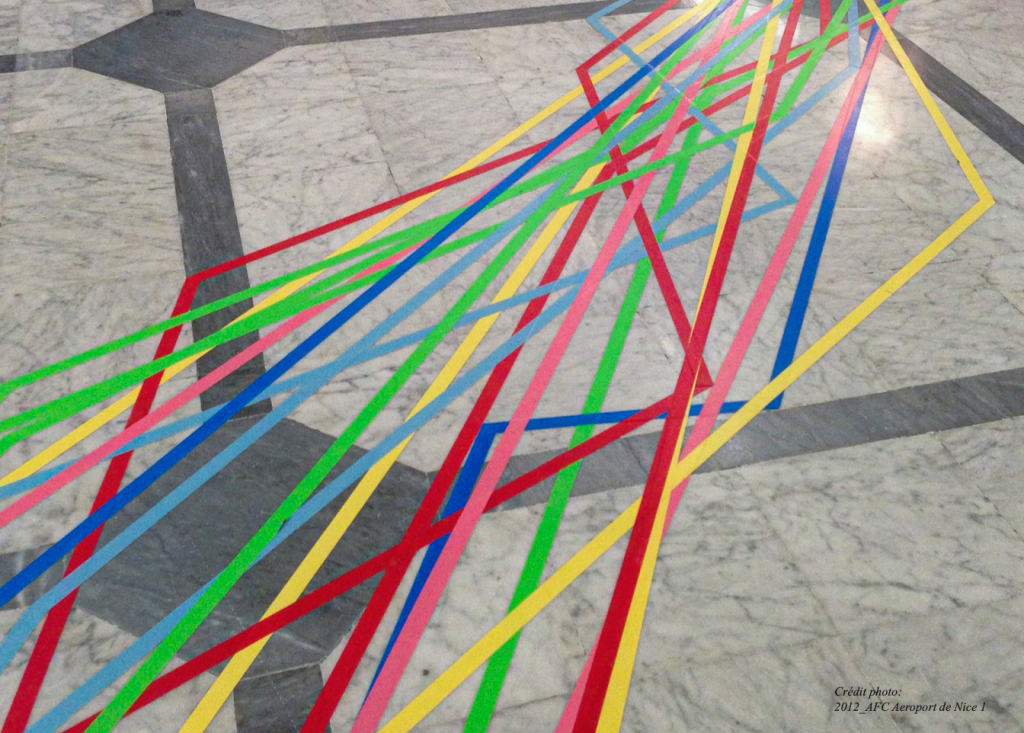BY MÉLISSA BURCKEL, ARTISTIC DIRECTOR, CURATOR
BY MÉLISSA BURCKEL, ARTISTIC DIRECTOR, CURATOR
Anne-Flore Cabanis is a French artist who graduated from the École Nationale Supérieure des Beaux-Arts de Paris. Since 2001, she has been drawing a random line with pencil on paper. This writing obeys simple rules: a freehand-drawn line that does not cross itself, incorporating only right angles. After a study trip to Brazil in 2005, she translates this language in space through different forms: performances, sound pieces, in-situ tape collages and installations in volumes of stretched lines.
Her projects have recently led her to work at the CENTQUATRE-PARIS, in a college in Aubervilliers (93), at the Metz train station, at La Filature (Mulhouse national stage), and abroad in the Ixelles district of Brussels in Belgium, as well as in the city of Taipei in Taiwan. She lives and works in Paris.
It is in 2013, during one of my 22:22 evenings, organized at one of the mythical clubs of the capital, the Bus Palladium, that I met the artist Anne-Flore Cabanis. The concept of the evening consisted in inviting a personality from the culture world and asking him or her to program three musical artists and one artist to exhibit. Julie Gayet, actress and film producer, was our third programmer, and it was on this occasion that she introduced me to the works of Anne-Flore Cabanis.
I remembered having already been impressed by her monumental installation entitled Connexions, made at the CENTQUATRE-PARIS one year earlier. Watching the teaser of this exhibition, one realized the precision that such an installation requires and the “accurate” place that is offered to a work of art in the immensity of a reception area.
Seeing Anne-Flore Cabanis running from one end of the nave of the CENTQUATRE-PARIS to install these colored strips, I had the vision of a kind of ritual, a true artistic choreography, a poetic ballet…
Do constraints abolish all forms of improvisation in the creative process?
Anne-Flore Cabanis gives us her point of view on this question during an interview in her studio in Romainville.

Mélissa Burckel: Hello, Anne-Flore, how are you?
Anne-Flore Cabanis: In this strange period that we are going through collectively, I feel that I am lucky, so everything is going well! I appreciate the small pleasures of life and I try to focus on the essential.
MB: Three words to describe what we have been living since March 18?
AFC: We are experiencing life and its challenges. It asks us to adapt to unpredictable situations and to draw inspiration from within ourselves to draw the positive from these new experiences. I don’t know if that’s a good description, but in any case, that’s the state of mind I’m aiming for. Not easy and very complex at times… I guess being humble in front of the world is a wise option. And then, what reassures perhaps, is that nothing is permanent, so this period will also pass!
MB: I wanted to discuss with you the subject of collaboration between artist and brand and, more specifically, the notion of constraint in art. You mainly work for public institutions, cities, art galleries and fairs. When I suggested you create an installation in a nightclub, what was your very first reaction?
AFC: My numerous interventions in urban space and the various collaborations with the CENTQUATRE-PARIS (during my residency and still today) have given me a taste for encounters with all types of public. Indeed, it is just as enriching to meet people where they are not expecting you with an artistic proposal as it is to invite them to discover it in a gallery or museum. So a nightclub or a night art event, why not! Moreover, the borders between the arts are permeable, and I had the chance to make some beautiful encounters in my career, especially in the theater with Jacques Bonnaffé and in music with Issam Krimi. Regarding the collaboration between artist and brand, in a way, it is the history of art that continues to be written: artists have always had private or public sponsors. And to use your formulation, I find “the notion of constraint in art” constitutive of the richness of the creative process. I can no longer count the number of projects that I think have been improved thanks to the constraints of the places that hosted them and thanks to unforeseen technical problems. This was once again true this year for my project Espace de rêves, a dream of space in the immense hopper of the headquarters of La Française des Jeux.

MB: For the project in the nightclub, you had to create an original installation that would be visible at night in a very complex space that welcomes the public. What was the most complicated constraint you had to work under?
AFC: You had to stay below a certain height for the safety of the public. I immediately considered the behavior of the public in a club and walking around in a dimly lit area as the main constraints. My proposal was adapted to create an invasive course that gives the sensation of movement. The club’s lights also helped to amplify certain effects.
MB: While visiting the event venue, we discovered technical constraints, such as a complex hanging system, delicate flooring and different ceiling heights. And to comply with safety standards, your elastic bands had to be fireproof before installation. Can these types of constraints disrupt your creative process?
AFC: Indeed, my first ideas were much crazier than those I finally realized. It’s always a bit like that. I aspire to make only the necessary concessions and to negotiate what can be negotiated in order to remain faithful to my project. This reminds me of the puzzle that was the formidable carte blanche given by the city of Metz for their all-nighter in 2012: the SNCF train station! This project was a fine example of stimulating complexity. The creative process in this case is certainly disrupted, but it’s my job to bounce back, and then I know that there’s always a nugget to be found in a challenge.
MB: You create monumental installations and, as with our project, it is impossible for you to do “test” installations beforehand. What is your working method?
AFC: I work with virtual and/or real models. I try to project myself on a real scale by making 30 cm x 30 cm formats. This is not obvious, but it is essential. For the Connections installation project in the Curial Nave of the CENTQUATRE-PARIS, I even validated certain passages of elastic bands on site with a laser, perched 6 meters high to make sure they would not be blocked by the columns of the building, and this was done within a few centimeters!

MB: Looking at all of your artistic work (paintings, drawings, videos, installations), we notice a common point related to mathematics, even quantum physics. Is this really the case?
AFC: I intuitively formulate principles that make you think about these areas of knowledge. I like the poetry that is sometimes found in scientific principles, such as the idea that our weight disappears in conditions of weightlessness, or the theory of relativity on the scale of the cosmos. In my artistic work, I like to propose human and sensitive experiences of these phenomena. For example, there are mathematical formulas that correspond to hyperbolic paraboloids, the forms taken by the in-situ installation Connexions au CENTQUATRE-PARIS. My artistic bias has been to make these forms so enormous that the body becomes a tool for the play of perceptions and, all of a sudden, space, or rather the perception of space, is transformed and moving. I am always very moved to see the dancers and jugglers, who are used to the place, mingle and become one with this installation. In the painting Molecules, it is the ambiguity between macroscopic and microscopic that interests me. In drawing, my “Ariadne’s thread of an imaginary labyrinth” – the execution of large-format drawings in a single line (which does not cross itself) – evokes the theory of scales or fractals.
MB: Which artists have inspired your work?
AFC: I was extremely impressed by a series of small drawings by Malevitch that I saw at the National Museum of Modern Art in Paris when I was a student at the Beaux-Arts. From a conceptual point of view, this artist brought me a lot when I discovered his 1918 Carré blanc sur fond blanc and his movement, Suprematism. It was like an initiation to engagement in an artistic expression close to spiritual experience. The works of Marina Abramovic, Joseph Beuys, Gina Pane and so many others are also very inspiring for me. Moreover, the force of the reasoning developed by Marcel Duchamp on his contemporary world has contributed intensely to my reflections as an artist, especially since it has had an inescapable influence on 20th century art.
MB: What installations have marked you the most?
AFC: Anish Kapoor’s Leviathan, which was shown in 2011 at the Grand Palais in Paris during the “Monumenta” exhibition, and Richard Serra’s installation Promenade, which I saw at the same event in 2008. In Japan, on a hill on the island of Teshima, I discovered the museum which is the result of the collaboration between the artist Rei Naito and the architect Ryue Nishizawa. And when I went to Naoshima Island, an archipelago of art, I was lucky enough to find myself in a place where “art, architecture and nature would become one”; it was an unforgettable moment.
MB: You did a drawing measuring 4.05 m x 3.36 m in a freehand line during a residency at CENTQUATRE-PARIS. The line never crossed itself. It took three months to complete your work. In what psychic state were you in during this period?
Did you impose a specific rhythm and lifestyle on yourself?
AFC: Three months for a single drawing is a long time. The advantage of this residency at CENTQUATRE-PARIS was that it gave me a framework without pressure. I simply worked, hour after hour. It didn’t require any particular lifestyle. On the other hand, this work required very demanding mental hygiene. Indeed, irritation, impatience, boredom and discouragement were daily feelings to overcome. It is at this precise point that everything came into play. I drew strength and initiatory determination from it.
MB: What are your next projects?
AFC: I’m producing a lot in the studio at the moment, especially paintings and drawings. In particular, I am preparing a solo exhibition to be held in a gallery in Taiwan. I am also exploring new subjects and conducting new research. In terms of in-situ installation, I am currently completing a project in the urban space of the participatory budget of the city of Paris, co-produced with CENTQUATRE-PARIS, at 54, avenue Simon-Bolivar in the 19th arrondissement. It is an intervention on a staircase leading to the Bergeyre mound, and I chose metal for this realization. Passers-by can already discover it.
MB: I can’t wait to see your new creation! Thank you, Anne-Flore.